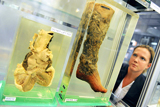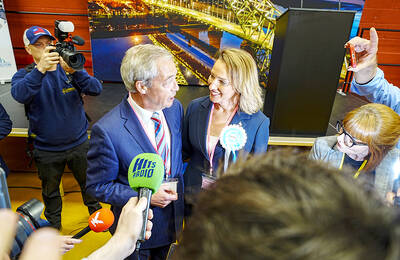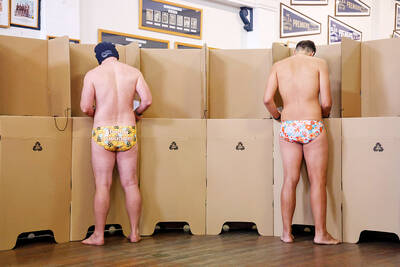Sydney’s Museum of Human Disease has opened its doors to the public, allowing visitors to view a Pandora’s box of plague, pestilence and disease in graphic detail.
Previously used as a resource for medical students at the University of New South Wales, the museum has more than 2,000 cadaver parts on display illustrating all manner of ailments afflicting the human body.
Located in the tranquil surrounds of the university campus in Sydney’s leafy eastern suburbs, the museum is not a place for the squeamish.

PHOTO: AFP
A blackened smoker’s lung sits opposite a nectrotic ulcer the size of a cricket ball, while in one perspex display case lies a misshapen knee labeled “gouty arthritis.”
Nearby, two disembodied white thumbs are set against a dark background in an exhibit that looks like a macabre parody of the “thumbs up” gesture.
Some of the illnesses displayed would be unfamiliar to those without a medical background, such as a nodular goiter and a gangrenous foot showing the impact of the blood-clotting condition Buergers’ Disease.
Others are all too common, including the museum’s “specimen of the week,” an egg-shaped breast cancer.
Curator Robert Lansdown admits the museum is confrontational but says it is a powerful educational tool, allowing the public to see first-hand how lifestyle choices such as smoking and eating fatty foods can affect the body.
“You only have to read the histories associated with some of the displays to see that this person was a smoker, or they were overweight,” Lansdown said. “People get a real appreciation of that when they come here.”
“They often only think about how their skin changes because it’s external, they don’t think about other organs, but over the course of someone’s lifetime they change a lot,” he said. “Your diet, drinking and exercise habits make a real difference, and that’s what people can see here.”
Lansdown said the museum was careful to treat the displays with respect, bearing in mind that they were once part of living human beings and should not be used for lurid entertainment.
“It’s obviously still extraordinary, confronting and graphic for people but it’s done in a way that gives them the opportunity to learn,” he said.
Visitors to the museum are given a set of headphones attached to a device that allows them to access recordings of pathologists discussing the exhibits on display.
Lansdown, a high school science teacher before he took over the collection three years ago, said most of the visitors since the museum opened to the public a few weeks ago had been older people.
“It’s perhaps because they’ve had more exposure to diseases and they may know somebody suffering from one of these conditions,” he said. “Although it’s quite upsetting initially, they then can understand it better.”
“For the general public, and also for pathologists and doctors, the best way to learn about these things is to see them,” Lansdown said.
He said one man recently came in who was suffering asbestosis, an irreversible lung-scarring disease caused by exposure to asbestos dust.
While the man was familiar with the symptoms and cause of the disease, he simply wanted to see what was occurring inside his body, Lansdown said.
He said some visitors became queasy and the groups of senior high school students who regularly arrived for guided tours often responded with initial comments such as “gross” and “disgusting.”
Lansdown said brains, feet and hands tended to produce the strongest reaction.

Kehinde Sanni spends his days smoothing out dents and repainting scratched bumpers in a modest autobody shop in Lagos. He has never left Nigeria, yet he speaks glowingly of Burkina Faso military leader Ibrahim Traore. “Nigeria needs someone like Ibrahim Traore of Burkina Faso. He is doing well for his country,” Sanni said. His admiration is shaped by a steady stream of viral videos, memes and social media posts — many misleading or outright false — portraying Traore as a fearless reformer who defied Western powers and reclaimed his country’s dignity. The Burkinabe strongman swept into power following a coup in September 2022

‘FRAGMENTING’: British politics have for a long time been dominated by the Labor Party and the Tories, but polls suggest that Reform now poses a significant challenge Hard-right upstarts Reform UK snatched a parliamentary seat from British Prime Minister Keir Starmer’s Labor Party yesterday in local elections that dealt a blow to the UK’s two establishment parties. Reform, led by anti-immigrant firebrand Nigel Farage, won the by-election in Runcorn and Helsby in northwest England by just six votes, as it picked up gains in other localities, including one mayoralty. The group’s strong showing continues momentum it built up at last year’s general election and appears to confirm a trend that the UK is entering an era of multi-party politics. “For the movement, for the party it’s a very, very big

ENTERTAINMENT: Rio officials have a history of organizing massive concerts on Copacabana Beach, with Madonna’s show drawing about 1.6 million fans last year Lady Gaga on Saturday night gave a free concert in front of 2 million fans who poured onto Copacabana Beach in Rio de Janeiro for the biggest show of her career. “Tonight, we’re making history... Thank you for making history with me,” Lady Gaga told a screaming crowd. The Mother Monster, as she is known, started the show at about 10:10pm local time with her 2011 song Bloody Mary. Cries of joy rose from the tightly packed fans who sang and danced shoulder-to-shoulder on the vast stretch of sand. Concert organizers said 2.1 million people attended the show. Lady Gaga

SUPPORT: The Australian prime minister promised to back Kyiv against Russia’s invasion, saying: ‘That’s my government’s position. It was yesterday. It still is’ Left-leaning Australian Prime Minister Anthony Albanese yesterday basked in his landslide election win, promising a “disciplined, orderly” government to confront cost-of-living pain and tariff turmoil. People clapped as the 62-year-old and his fiancee, Jodie Haydon, who visited his old inner Sydney haunt, Cafe Italia, surrounded by a crowd of jostling photographers and journalists. Albanese’s Labor Party is on course to win at least 83 seats in the 150-member parliament, partial results showed. Opposition leader Peter Dutton’s conservative Liberal-National coalition had just 38 seats, and other parties 12. Another 17 seats were still in doubt. “We will be a disciplined, orderly